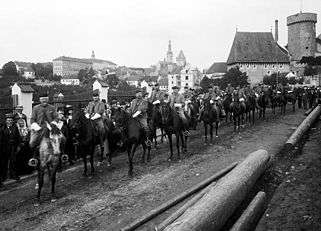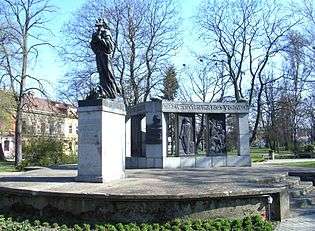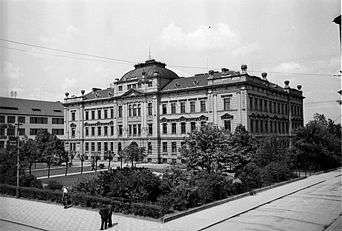Tábor
| Tábor | |||
| Town | |||
 Southwest corner of the Žižka's square as viewed from the church tower | |||
|
|||
| Country | Czech Republic | ||
|---|---|---|---|
| Region | South Bohemian | ||
| District | Tábor | ||
| Commune | Tábor | ||
| River | Lužnice | ||
| Elevation | 437 m (1,434 ft) | ||
| Coordinates | CZ 49°24′N 14°39′E / 49.400°N 14.650°ECoordinates: CZ 49°24′N 14°39′E / 49.400°N 14.650°E | ||
| Highest point | |||
| - elevation | 476 m (1,562 ft) | ||
| Lowest point | |||
| - elevation | 384 m (1,260 ft) | ||
| Area | 62.22 km2 (24.02 sq mi) | ||
| Population | 34,716 (2015) | ||
| Density | 558/km2 (1,445/sq mi) | ||
| Founded | 1420 | ||
| Mayor | Jiří Fišer | ||
| Timezone | CET (UTC+1) | ||
| - summer (DST) | CEST (UTC+2) | ||
| Postal code | 390 01 | ||
  Location in the Czech Republic | |||
| Wikimedia Commons: Tábor | |||
| Statistics: statnisprava.cz | |||
| Website: www.tabor.cz | |||
Tábor (Czech pronunciation: [ˈtaːbor]; German: Tabor) is a city of the Czech Republic, in the South Bohemian Region. The name became popular and nowadays translates to "camp" or "encampment" in Czech.[1]
History
The town was founded in the spring of 1420 by Petr Hromádka of Jistebnice and Jan Bydlínský of Bydlín from the most radical wing of the Hussites, who soon became known as the Taborites. The town is iconic for the years in which it flourished as an egalitarian peasant commune. This spirit is celebrated in Smetana's "Song of Freedom", made famous in the English-speaking world by Paul Robeson's recording in Czech and English.
The historical part of the town is situated on the summit of an isolated hill separated from the surrounding country by the Lužnice river and by an extensive lake, to which the Hussites gave the biblical name of Jordan. This lake, founded 1492, is the oldest reservoir of its kind in Central Europe. The historical importance of the city of Tábor ceased only when it was captured by King George of Poděbrady in 1452.
Until 1918, the post town "TABOR - TÁBOR" was part of the Austrian monarchy (Austria side after the compromise of 1867), in the district with the same name, one of the 94 Bezirkshauptmannschaften in Bohemia.[2]
The TABOR BAHNHOF - TÁBOR NÁDRAŽÍ post-office was opened in 1895.
Geography
Though a large part of the ancient fortifications has been demolished, Tábor (or Hradiště Hory Tábor, the castle of the Tábor Hill, as it was called in the Hussite period) still preserves many memorials of its past fame. In the centre of the city is Žižka Square. Only very narrow streets lead to it, to render the approach to it more difficult in time of war. First-time visitors may not even suspect that there is an ingenious labyrinth of tunnels under the houses and streets here. The townspeople dug cellars under their houses and these were subsequently interconnected; an approximately 1 km-long section of the tunnel system is open to the public.
In the centre of the square is the statue of Jan Žižka, the greatest of the Hussite leaders. Here also is the Dean Church of Lord's Conversion on Mount Tabor, built in 1516 in the style of the Bohemian Renaissance, and the town hall, in connection with which a museum has been founded, which contains interesting memorials of the Hussite period, such as farm carts which doubled as battle wagons. Major parts of the ancient fortifications and the ancient Kotnov tower and gate of Bechyně near the tower still exist.
The Districts of Tábor
Čekanice, Čelkovice, Hlinice, Horky, Klokoty, Měšice, Náchod, Smyslov, Stoklasná Lhota, Sídliště Nad Lužnicí, Větrovy, Všechov, Zahrádka, Záluží, Zárybničná Lhota.
International relations
Twin towns — Sister cities
Tábor is twinned with the following cities:
 Konstanz, Germany
Konstanz, Germany Dole, France
Dole, France Orinda, United States of America
Orinda, United States of America Wels, Austria
Wels, Austria Škofja Loka, Slovenia
Škofja Loka, Slovenia.svg.png) Sint-Niklaas, Belgium
Sint-Niklaas, Belgium
Gallery
 Church and statue of Roland.
Church and statue of Roland. View of Tábor from north, end of 19th century, with well visible city fortification, Ignác Šechtl
View of Tábor from north, end of 19th century, with well visible city fortification, Ignác Šechtl Square of Jan Žižka with city hall and church, 1895, Ignác Šechtl
Square of Jan Žižka with city hall and church, 1895, Ignác Šechtl Kotnov tower with Sokol parrade, 1902, Šechtl and Voseček
Kotnov tower with Sokol parrade, 1902, Šechtl and Voseček View of Old city Tábor (2007)
View of Old city Tábor (2007) Tabor-view from river Lužnice – 2007
Tabor-view from river Lužnice – 2007 Monument Jan Hus-sculptor František Bílek (making 1928)
Monument Jan Hus-sculptor František Bílek (making 1928) Cloister Klokoty – Winter 2007
Cloister Klokoty – Winter 2007 Old Town, Šechtl and Voseček
Old Town, Šechtl and Voseček School of Agriculture, approx. 1935, Josef Jindřich Šechtl
School of Agriculture, approx. 1935, Josef Jindřich Šechtl
References
Sources
- Augusta, Pavel / Klínková, Hana: TÁBOR, ISBN 80-86098-18-4 (Tábor 2001).
External links
| Wikimedia Commons has media related to Tábor. |
| Wikivoyage has a travel guide for Tábor. |
- Official website of the city
- A website about the city
- Historical photographs of the city
- The tunnels, with photo

